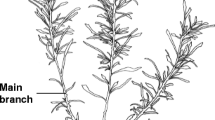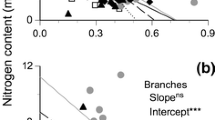Summary
The productivity of the final larval and adult populations of a large sized diplopod,Japonaria laminata armigera were studied at a warm temperate ever-green broad leaf forest in Chiba Japan. The population density was about 200/m2 in May 1962, and 7/m2 in May 1966, the former being about 30 times as much as the latter. A remarkable growth of animals was seen from June to November, and the growth pattern of individuals in both populations was very similar. The growth and mortality were calculated by the following formulae,
whereG is growth,M mortality,N t number at the timet,W t −1 mean body weight of animals at the timet−1, ΔN decrease in number during the period of time fromt−1 tot, ΔW growth in mean body weight during the time fromt−1 tot. The constantb in the formulaR=aW b representing the relation between body weight and oxygen consumption ofJaponaria laminata was determined at 0.81, andQ 10 was estimated at about 2. The amounts of growth and assimilation were calculated. The pattern of dynamics in terms of productivity of the population in the two periods were very similar. But, the amounts of assimilation were computed at 57.8 kcal/m2/from May 1962 to April 1963, and 3.01 kcal from May 1966 to April 1967. The former is 20 times as much as the latter. The growth or ecological efficiencies for the populations were similar.
Similar content being viewed by others
References
Bocock, K. L. (1963) The digestion and assimilation of food byGlomeris. InSoil organisms (ed. byDoeksen andVan Der Drift). 85–91. Amsterdam.
Brody, S. (1945)Bioenergetics and growth. New York.
Buckner, C. H. (1964) Metabolism, food capacity, and feeding behaviour in four species of shrews.Can. J. Zool. 42: 259–279.
Causey, N. B. (1943) Studies on the life history and the ecology of the hot house millipede,Orthomorpha gracilis.Amer. Midl. Nat. 2: 670–682.
Engelmann, M. D. (1961) The role of soil arthropods in the energetics of an old field community.Ecol. Monogr. 31: 221–238.
Esaki, T. (1934) Diplopoda that stopps the train.Plants and animals. 2: 19–24. (In Japanese)
Gere, G. (1956) The examination of the feeding biology and the humificative function of Diplopoda and Isopoda.Acta Biol. Hung. 6: 257–271.
Gere, G. (1962) Ernährungsbiologische Untersuchungen an Diplopoden.Acta Zool. Hung. 8: 25–38.
Itô, Y. (1964) Preliminary studies on the respiratory energy loss of a spider,Lycosa pseudoannulata.Res. Popul. Ecol. 4: 13–21.
Kitazawa, Y. (1959) Bio-economic study of natural populations of animals.Jap. J. Zool. 12: 401–448.
Kitazawa, Y. (1966) Community metabolism of soil invertebrates in three forest ecosystems of Japan.Warsaw Symp. on Sec. Prod. Terr. Ecos. 13 pp.
Murakami, Y. (1966) Postembryonic development of the common Myriapoda XXIII. Some observations of the life history ofPhrurodesmus kishaensis (Leptodesmidae).Zool. Mag. 75: 309–313. (In Japanese with English summary)
Odum, E. P., C. E. Connell, andL. B. Davenport (1962) Population energy flow of three primary consumer components of old-field ecosystems.Ecol. 43: 88–96.
Phillipson, J. (1966) Invertebrates reproducing more than once in the life time.Warsaw Symp. on Sec. Prod. Terr. Ecos. 25 pp.
Phillipson, J. (1966a) Studies on the bionergetics of woodland diplopoda.Ibid. Warsaw Symp. on Sec. Prod. Terr. Ecos. 6 pp.
Phillipson, J. andJ. Watson (1965) Respiratory metabolism of the terrestrial isopodOniscus asellus L.Oikos. 16: 78–87.
Richman, S. (1958) The transformation of energy byDaphnia pulex.Ecol. 28: 273–291.
Saito, S. (1965) Structure and energetics of the population ofLigidium japonicum (Isopoda) in a warm temperate forest ecosystem.Jap. J. Ecol. 15: 47–55.
Shinohara, K. (1958) Polydesmoidea millipeds from Chichibu.Bull. Chichibu Museum Nat. Hist. 8: 19–24. (In Japanese with English summary)
Slobodkin, L. B. (1961) Preliminary ideas for a predictive theory of ecology.Amer. Nat. 95: 145–153.
Slobodkin, L. B. (1962) Energy in animal ecology.Adv. Ecol. Res. 1: 69–101.
Smalley, A. E. (1960) Energy flow of a slat marsh grasshopper population.Ecol.,41: 772–777.
Suzuki, T. andK. Wada (1949) The warm temperate forest vegetation of Province Awa.Bull. Tokyo Univ. Forests. 37; 115–134. (In Japanese with English summary)
Teal, J. M. (1957) Community metabolism in a temperate cold spring.Ecol. 27: 283–302.
Wiegert, R. G. (1964) Population energeties of meadow spittle bugs (Philaenus spurmarius L.) as affected by migration and habitat.Ecol. Monogr. 34: 217–241.
Wiegert, R. G. (1965) Energy dynamics of the grasshopper populations in old field and alfalfa ecosystems.Oikos. 16: 161–176.
Wolvekamp, H. P. andT. H. Waterman (1960) Respiration. InThe physiology of crustacea (ed. byWaterman),1: 35–100, New York.
Author information
Authors and Affiliations
Additional information
Contributions from JIBP-PT No. 26.
Rights and permissions
About this article
Cite this article
Saito, S. Productivity of high and low density populations ofJaponaria laminata armigera (Diplopoda) in a warm-temperate forest ecosystem. Res Popul Ecol 9, 153–166 (1967). https://doi.org/10.1007/BF02514922
Issue Date:
DOI: https://doi.org/10.1007/BF02514922




